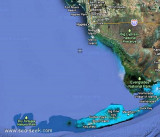

| Latitude | Longitude | |
| DMS | --- | --- |
| DM | --- | --- |
| DD | --- | --- |


 Le golfe du Mexique est la neuvième plus grande du corps de l'eau dans le monde. La forme de son bassin est à peu près ovale et environ 810 miles nautiques (1.500 km) de large et rempli de roches sédimentaires et des débris. Le marnage est très faible en raison de la connexion étroite avec l'océan.
Le golfe du Mexique est la neuvième plus grande du corps de l'eau dans le monde. La forme de son bassin est à peu près ovale et environ 810 miles nautiques (1.500 km) de large et rempli de roches sédimentaires et des débris. Le marnage est très faible en raison de la connexion étroite avec l'océan.Le golfe du Mexique communique au sud-est avec la mer des Caraïbes par le canal du Yucatán et à l'est avec l'océan Atlantique par le détroit de Floride.
Les côtes est, nord et nord-est du golfe s'étendent le long des États de Floride, d'Alabama, du Mississippi, de Louisiane et du Texas. Cette ligne côtière s'étend sur 2 700 km et reçoit les eaux de 33 fleuves majeurs ayant traversé 31 États. Les côtes du sud et du sud-ouest s'étendent le long des États mexicains de Tamaulipas, Veracruz, Tabasco, Campeche, Yucatán et de Quintana Roo. Au sud-est se retrouve l'île de Cuba.
Le littoral du golfe est truffé de nombreuses petites baies et criques. De nombreux fleuves s'y jettent, et plus particulièrement le fleuve Mississippi dans le nord du golfe, ainsi que le ríosi que de plages de sable. Le golfe du Mexique est un excellent exemple de marge passive. Le plateau continental est relativement large à plusiees principaux points et entrées de port sont indiqués par des feux, qui sont le guide principal pour approcher ou rester le long de la côte.
Le Gulf Stream, un courant chaud de l'océan Atlantique et l'un des plus forts courants marins connus, prend son origine dans le golfe, dans la continuité de la boucle de courant Caraïbes-Yucatán. Les autres caractéristiques de courants océaniques incluent des vortex anticycloniques qui sont générés par la boucle et qui se déplacent vers l'ouest où ils finissent par se dissiper. On trouve également un vortex cyclonique dans la baie de Campeche.
L'eau chaude du golfe peut alimenter de puissants ouragans prenant naissance dans l'Atlantique et causant de lourdes pertes humaines et matérielles, comme ce fut le cas avec l'ouragan Katrina en 2005. Dans l'océan Atlantique, un ouragan a tendance à faire remonter à la surface l'eau froide des profondeurs, ce qui diminue la probabilité qu'un autre ouragan suive dans son sillage (car une eau chaude est une condition préalable à la formation d'un ouragan). Toutefois, la faible profondeur des eaux du golfe implique une colonne d'eau relativement chaude. En conséquence, quand un cyclone passe au-dessus, même si la température de l'eau peut vite descendre, elle rebondit généralement tout aussi rapidement et peut ainsi être le berceau d'une autre tempête tropicale.
Bien que la zone du golfe soit considérée comme asismique, de légers tremblements de terre ont été enregistrés au cours de l'histoire (en général moins de 5,0 sur l'échelle de Richter). Le 10 septembre 2006, un tremblement de 6,0 a été enregistré à 400 km au large des côtes de la Floride. Celui-ci n'a causé aucun dégât, mais il a été ressenti dans tout le sud des États-Unis.
 The Gulf of Mexico is the ninth largest body of water in the world. The shape of its basin is roughly oval and approximately 810 nautical miles (1,500 km) wide and filled with sedimentary rocks and debris. Tidal ranges are extremely small due to the narrow connection with the ocean.
The Gulf of Mexico is the ninth largest body of water in the world. The shape of its basin is roughly oval and approximately 810 nautical miles (1,500 km) wide and filled with sedimentary rocks and debris. Tidal ranges are extremely small due to the narrow connection with the ocean. Considered a smaller part of the Atlantic Ocean, it is an ocean basin largely surrounded by the North American continent and the island of Cuba. It is bounded on the northeast, north and northwest by the Gulf Coast of the United States, on the southwest and south by Mexico, and on the southeast by Cuba.
It is part of the Atlantic Ocean through the Florida Straits between the U.S. and Cuba, and with the Caribbean Sea (with which it forms the American Mediterranean Sea) via the Yucatan Channel between Mexico and Cuba.
Today, there are 7 main areas of the gulf:
Gulf of Mexico Basin, which contains the Sigsbee Deep and can be further divided into the continental rise, the Sigsbee Abyssal Plain, and the Mississippi Cone.
Northeast Gulf of Mexico, which extends from just east of the Mississippi Delta near Biloxi to the eastern side of Apalachee Bay.
South Florida Continental Shelf and Slope, which extends along the coast from Apalachee Bay to the Straits of Florida and includes the Florida Keys and Dry Tortugas.
Campeche Bank, which extends from the Yucatan Straits in the east to the Tabasco-Campeche Basin in the west and includes Arrecife Alacran.
Bay of Campeche, which is an isthmian embayment extending from the western edge of Campeche Bank to the offshore regions just east of the port of Veracruz.
Western Gulf of Mexico, which is located between Veracruz to the south and the Rio Grande to the north.
Northwest Gulf of Mexico, which extends from Alabama to the U.S.-Mexico border.
The Gulf of Mexico's eastern, north, and northwestern shores lie along the US states of Florida, Alabama, Mississippi, Louisiana, and Texas.
The US portion of the Gulf coastline spans 1,680 miles (2,700 km), receiving water from thirty-three major rivers that drain 31 states. The Gulf's southwestern and southern shores lie along the Mexican states of Tamaulipas, Veracruz, Tabasco, Campeche, Yucatán, and the northernmost tip of Quintana Roo. The Mexican portion of the Gulf coastline spans 1,394 miles (2,243 km). On its southeast quadrant the Gulf is bordered by Cuba. It supports major American, Mexican and Cuban fishing industries. The outer margins of the wide continental shelves of Yucatán and Florida receive cooler, nutrient-enriched waters from the deep by a process known as upwelling, which stimulates plankton growth in the euphotic zone. This attracts fish, shrimp, and squid. River drainage and atmospheric fallout from industrial coastal cities also provide nutrients to the coastal zone.
The Bay of Campeche in Mexico constitutes a major arm of the Gulf of Mexico. Additionally, the gulf's shoreline is fringed by numerous bays and smaller inlets. A number of rivers empty into the gulf, most notably the Mississippi River in the northern gulf, and the Grijalva and Usumacinta Rivers in the southern gulf. The land that forms the gulf's coast, including many long, narrow barrier islands, is almost uniformly low-lying and is characterized by marshes and swamps as well as stretches of sandy beach. The Gulf of Mexico is an excellent example of a passive margin. The continental shelf is quite wide at most points along the coast, most notably at the Florida and Yucatán Peninsulas.
The principal points and harbor entrances are marked by lights, which are the chief guides for approaching or standing along the coast.
The Gulf Stream, a warm Atlantic Ocean current and one of the strongest ocean currents known, originates in the gulf, as a continuation of the Caribbean Current-Yucatán Current-Loop Current system. Other circulation features include the anticyclonic gyres which are shed by the Loop Current and travel westward where they eventually dissipate, and a permanent cyclonic gyre in the Bay of Campeche.
The gulf's warm water temperature can feed powerful Atlantic hurricanes causing extensive human death and other destruction as happened with Hurricane Katrina in 2005. In the Atlantic, a hurricane will draw up cool water from the depths and making it less likely that further hurricanes will follow in its wake (warm water being one of the preconditions necessary for their formation). However, the Gulf is shallower and its entire water column is warm. When a hurricane passes over, although the water temperature may drop it soon rebounds and becomes capable of supporting another tropical storm.
The Gulf is considered aseismic: however, mild tremors have been recorded throughout history (usually 5.0 or less on the Richter scale). A 6.0 tremor was recorded on September 10, 2006, 250 miles (400 km) off the coast of Florida which caused no damage, but could be felt throughout the Southeastern United States. No damage or injuries were reported.
Earthquakes such as this may be caused by interactions between sediment loading on the sea floor and adjustment by the crust.
Ebook | Gulf of Mexico
|







